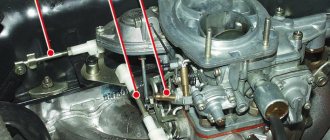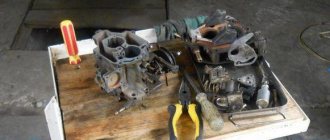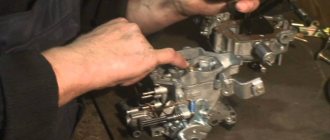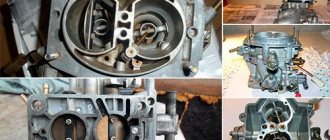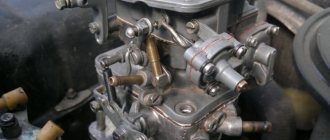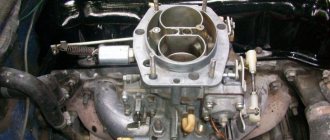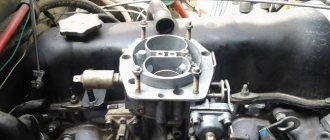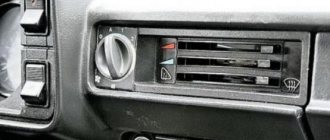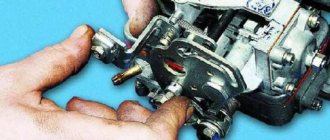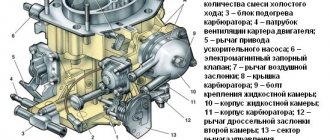Every car owner should have at least a general understanding of its structure. No repair can be done without such knowledge, and when it comes to tuning the performance of a car, then it is imperative to know its structure.
An important part of an internal combustion engine is the carburetor - a device in which air and fuel are mixed. The result is a flammable mixture of the consistency necessary for the operation of the power unit.
When it comes to domestic carburetors, one cannot fail to mention the Solex 21083 - one of the best devices in its class, with excellent performance and high reliability. This model has one undeniable advantage in its arsenal - it can be modified in a wide variety of ways, thereby “tailoring” the carburetor to specific operating conditions.
What are jets
As a rule, modification of the carburetor consists of replacing the jets. Jets are small metering elements with holes of a certain cross-sectional area through which the components of the combustible mixture pass. This article will discuss the jets of the Solex 21083 carburetor.
Types and classification of jets
To create a good lean mixture, fuel jets with a small cross-section of the hole must be installed in the carburetor, and air jets with a larger cross-section. Using this scheme allows the engine to operate stably even with sudden changes in driving mode.
The Solex 21083 carburetor is equipped with two types of jets:
- Fuel. Ensures a uniform flow of fuel into the carburetor chamber.
- Airborne. Dose the air supply to the carburetor.
Car owners for the most part prefer to reduce the appetite of the power unit, so the optimal solution would be to install a combination of jets that reduces fuel consumption (sometimes it is possible to improve this figure by a third). To choose suitable jets, you need to understand their markings, which are not as complicated as they might seem at first glance.
Adjusting the Solex 21083 carburetor
The Solex carburetor has several types of adjustments, and you can adjust:
- gasoline level in the float chamber;
- number of minimum idle speeds;
- qualitative composition of the fuel mixture (FC) using the idle speed screw (IQ).
Adjusting the quality of the vehicle is very simple, and any car owner can do the adjustment with his own hands. To do this, you need to warm up the engine well and set the speed screw to 800-900 rpm. Then:
- tighten the quality screw until the internal combustion engine begins to operate with some interruptions and reduce the number of revolutions;
- We unscrew the screw so that the motor starts running smoothly again, usually one turn is enough. If the screw is loosened too much, fuel consumption will increase.
Jet markings
When choosing jets for a carburetor, inexperienced car enthusiasts are often perplexed by the presence of several numbers in the jet markings. These symbols are deciphered as follows:
- The Solex 21083 carburetor as standard is equipped with jets marked 21 (for the first chamber) and 23 (for the second chamber). The numbers indicate the diameter of the dosing elements.
- On the bottom of the “original” fuel jets there are numbers 95 and 97.5 (the first and second chambers, respectively). This data displays the throughput of the jets.
- The air jets are marked in exactly the same way as in the previous example, only in this case they will be marked 155 and 125, indicating the performance of the parts. Naturally, these numbers will change on jets with different throughputs.
The marking of carburetor jets is quite simple, but simply recognizing the numerical values is not enough - you also need to understand how and what these indicators influence.
How to replace the rear wheel hub bearing can be found in our material.
See how to independently adjust the amount of light from your car headlights. Read more here.
An important parameter that affects the operation of the jets is the ratio of the amount of air and fuel in the chamber. The normal ratio is 14.9:1, at which fuel consumption and power are in balance. To determine the combination suitable for a particular driving style, it is enough to understand what the ratio of air and fuel in the combustible mixture will be.
The factory fuel jets of the Solex 21083 carburetor are designed for economical driving and have a fairly small cross-section . The original jets do not need to be changed unless there is a particular need to increase engine power. In addition, as a result of replacing the jets, the mixture may become too lean, and the engine simply will not have enough combustible mixture for normal operation.
If the engine is not running smoothly, and the problem clearly lies in the composition of the fuel mixture, you can think about the options: different configurations of fuel and air jets make it possible to choose the most efficient scheme and use it in your car to achieve suitable results.
Jet selection
When choosing a set of new jets for modifying a carburetor, it is worthwhile to thoroughly study this issue: Solex 21083 is modified very often, and a couple of additional tips from experienced drivers will not hurt. Recommendations for choosing most often sound like this:
- it is very important to take into account the engine volume: with a large displacement, it is better to choose air jets with a small cross-section in order to improve the combustible mixture;
- First of all, you should choose fuel jets, and only then look for air ones;
- The sequence is also important when installing jets: first they are installed in the first chamber, and only then in the second - this step-by-step approach will allow you to choose the most suitable scheme.
As an example of selecting jets for a 1.5-liter engine, you can consider the following combination:
- in the first chamber a fuel jet of 102.5 is installed, and the air jet has a cross-section of 155;
- For the second chamber, a fuel jet of 110 is selected, and an air jet is marked 125 or 135.
It is worth paying attention to the fact that Solex 21083 was originally designed for 1.5-liter engines , and its installation on a power unit with a large displacement is not recommended: due to the design features of this carburetor, an engine that is too “voluminous” will not receive sufficient quality flammable mixture.
It is also worth remembering that all Solex carburetors have a similar design, which ensures the interchangeability of their elements. This rule also applies to jets: if necessary, you can select jets from another carburetor that have a different cross-section for your version.
And the last recommendation: when selecting jets with a large cross-section, sometimes there is a desire to bore them yourself. This should not be done, since the operation of the jets requires the correct ratio, which cannot be achieved in “garage” conditions even with the appropriate equipment.
Installing a Solex 21053 carburetor on a classic
Now we can begin the process of replacing the original carburetor of the car with Solex modification 21053 1107010 20. On VAZs, the old carburetor is usually Ozone, produced on the basis of DAAZ. Its main problem is that it is not nearly as reliable as we would like. In addition, its fuel consumption is slightly higher than that of the Solex. That is why one is replaced by another. In addition, in order to simply install Solex 21053 on a classic, it is advisable to configure it correctly.
The procedure for installing the Solex 21053 carburetor on a classic is no different from installing other models of this device on it. Solex 21053 for classics can easily be placed in any rear-wheel drive VAZ engine. So, first you need to eliminate any possibility of foreign particles getting into the intake manifold. We achieve this goal by cleaning the engine compartment from dirt. There is no need to achieve perfect shine. Just wash it.
Tags: Solex, factory data, calibrations, 21041, 21073, 21053, 21051, 2108
Comments 39
For UZAM 2.0 in Solex-21041, what jets should I choose?
for starters (without knowing the engine compression, camshaft model) something like this: GTZh1=105-107.5 GVZh1=150ZD GTZh2=115-117.5-120 GVZh2=135ZC UN atomizer 40*40 (make it yourself from two 2108) or 45*40 (from 2108 and 21073) Cam UN No. 5, if not, then use No. 7. No. 4 as a last resort. TJ EMR=60 TJ XX 42.43 and further “to taste”
